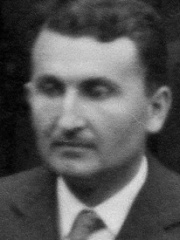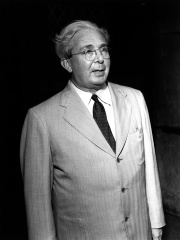
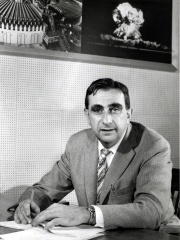
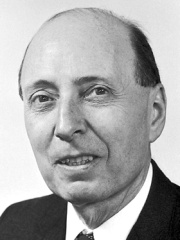
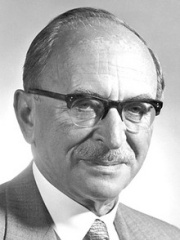
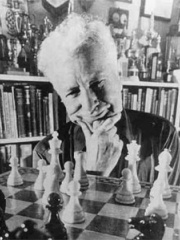
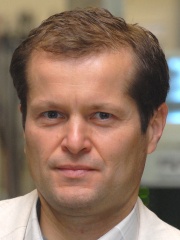

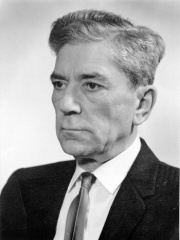
The Most Famous
PHYSICISTS from Hungary
This page contains a list of the greatest Hungarian Physicists. The pantheon dataset contains 851 Physicists, 11 of which were born in Hungary. This makes Hungary the birth place of the 15th most number of Physicists behind Switzerland, and Ukraine.
Top 10
The following people are considered by Pantheon to be the top 10 most legendary Hungarian Physicists of all time. This list of famous Hungarian Physicists is sorted by HPI (Historical Popularity Index), a metric that aggregates information on a biography's online popularity. Visit the rankings page to view the entire list of Hungarian Physicists.

1. Leo Szilard (1898 - 1964)
With an HPI of 78.22, Leo Szilard is the most famous Hungarian Physicist. His biography has been translated into 55 different languages on wikipedia.
Leo Szilard (; Hungarian: Leó Szilárd [ˈlɛoː ˈsilaːrd]; born Leó Spitz; February 11, 1898 – May 30, 1964) was a Hungarian-born American physicist, biologist and inventor who made numerous important discoveries in nuclear physics and the biological sciences. He conceived the nuclear chain reaction in 1933, and patented the idea in 1936. In late 1939 he wrote the letter for Albert Einstein's signature that resulted in the Manhattan Project that built the atomic bomb, and then in 1945 wrote the Szilard petition asking president Harry S. Truman to demonstrate the bomb without dropping it on civilians. According to György Marx, he was one of the Hungarian scientists known as The Martians. Szilard initially attended Palatine Joseph Technical University in Budapest, but his engineering studies were interrupted by service in the Austro-Hungarian Army during World War I. He left Hungary for Germany in 1919, enrolling at Technische Hochschule (Institute of Technology) in Berlin-Charlottenburg (now Technische Universität Berlin), but became bored with engineering and transferred to Friedrich Wilhelm University, where he studied physics. He wrote his doctoral thesis on Maxwell's demon, a long-standing puzzle in the philosophy of thermal and statistical physics. Szilard was the first scientist of note to recognize the connection between thermodynamics and information theory. Szilard coined and submitted the earliest known patent applications and the first publications for the concept of the electron microscope (1928), the cyclotron (1929), and also contributed to the development of the linear accelerator (1928) in Germany. Between 1926 and 1930, he worked with Einstein on the development of the Einstein refrigerator. After Adolf Hitler became chancellor of Germany in 1933, Szilard urged his family and friends to flee Europe while they still could. He moved to England, where he helped found the Academic Assistance Council, an organization dedicated to helping refugee scholars find new jobs. While in England, he discovered a means of isotope separation known as the Szilard–Chalmers effect, alongside Thomas A. Chalmers. Foreseeing another war in Europe, Szilard moved to the United States in 1938, where he worked with Enrico Fermi and Walter Zinn on means of creating a nuclear chain reaction. He was present when this was achieved within the Chicago Pile-1 on December 2, 1942. He worked for the Manhattan Project's Metallurgical Laboratory at the University of Chicago on aspects of nuclear reactor design, where he was the chief physicist. He drafted the Szilard petition advocating a non-lethal demonstration of the atomic bomb, but the Interim Committee chose to use them in a military strike instead. Together with Enrico Fermi, he applied for a nuclear reactor patent in 1944. He publicly sounded the alarm against the possible development of salted thermonuclear bombs, a new kind of nuclear weapon that might annihilate mankind. His inventions, discoveries, and contributions related to biological science are also equally important; they include the discovery of feedback inhibition and the invention of the chemostat. According to Theodore Puck and Philip I. Marcus, Szilard gave essential advice which made the earliest cloning of the human cell a reality. Diagnosed with bladder cancer in 1960, he underwent a cobalt-60 treatment that he had designed. He helped found the Salk Institute for Biological Studies, where he became a resident fellow. Szilard founded Council for a Livable World in 1962 to deliver "the sweet voice of reason" about nuclear weapons to Congress, the White House, and the American public. He died in his sleep of a heart attack in 1964.

2. Edward Teller (1908 - 2003)
With an HPI of 77.35, Edward Teller is the 2nd most famous Hungarian Physicist. His biography has been translated into 72 different languages.
Edward Teller (Hungarian: Teller Ede; January 15, 1908 – September 9, 2003) was a Hungarian-American theoretical physicist and chemical engineer who is known colloquially as "the father of the hydrogen bomb" and one of the creators of the Teller–Ulam design inspired by Stanisław Ulam. Born in Austria-Hungary in 1908, Teller emigrated to the US in the 1930s, one of the many so-called "Martians", a group of Hungarian scientist émigrés. He made numerous contributions to nuclear and molecular physics, spectroscopy, and surface physics. His extension of Enrico Fermi's theory of beta decay, in the form of Gamow–Teller transitions, provided an important stepping stone in its application, while the Jahn–Teller effect and Brunauer–Emmett–Teller (BET) theory have retained their original formulation and are mainstays in physics and chemistry. Teller made contributions to Thomas–Fermi theory, the precursor of density functional theory, a standard tool in the quantum mechanical treatment of complex molecules. In 1953, with Nicholas Metropolis, Arianna Rosenbluth, Marshall Rosenbluth, and Augusta Teller, Teller co-authored a paper that is a starting point for the application of the Monte Carlo method to statistical mechanics and the Markov chain Monte Carlo literature in Bayesian statistics. Teller was an early member of the Manhattan Project, which developed the atomic bomb. He made a concerted push to develop fusion-based weapons, but ultimately fusion bombs only appeared after World War II. To get support for the hydrogen bomb project, Teller supported and worked on the George shot of the Operation Greenhouse nuclear tests, resulting in the world's first thermonuclear burn. He co-founded the Lawrence Livermore National Laboratory and was its director or associate director. After his controversial negative testimony in the Oppenheimer security clearance hearing of his former Los Alamos Laboratory superior, J. Robert Oppenheimer, the scientific community ostracized Teller. Teller continued to find support from the US government and military research establishment, particularly for his advocacy for nuclear power development, a strong nuclear arsenal, and a vigorous nuclear testing program. In his later years, he advocated controversial technological solutions to military and civilian problems, including a plan to excavate an artificial harbor in Alaska using a thermonuclear explosive in what was called Project Chariot, and Ronald Reagan's Strategic Defense Initiative. Teller was a recipient of the Enrico Fermi Award and Albert Einstein Award. He died in 2003, at 95.

3. Eugene Wigner (1902 - 1995)
With an HPI of 75.92, Eugene Wigner is the 3rd most famous Hungarian Physicist. His biography has been translated into 87 different languages.
Eugene Paul Wigner (Hungarian: Wigner Jenő Pál, pronounced [ˈviɡnɛr ˈjɛnøː ˈpaːl]; November 17, 1902 – January 1, 1995) was a Hungarian-American theoretical physicist who also contributed to mathematical physics. He received the Nobel Prize in Physics in 1963 "for his contributions to the theory of the atomic nucleus and the elementary particles, particularly through the discovery and application of fundamental symmetry principles". A graduate of the Technical Hochschule Berlin (now Technische Universität Berlin), Wigner worked as an assistant to Karl Weissenberg and Richard Becker at the Kaiser Wilhelm Institute in Berlin, and David Hilbert at the University of Göttingen. Wigner and Hermann Weyl were responsible for introducing group theory into physics, particularly the theory of symmetry in physics. Along the way he performed ground-breaking work in pure mathematics, in which he authored a number of mathematical theorems. In particular, Wigner's theorem is a cornerstone in the mathematical formulation of quantum mechanics. He is also known for his research into the structure of the atomic nucleus. In 1930, Princeton University recruited Wigner, along with John von Neumann, and he moved to the United States, where he obtained citizenship in 1937. Wigner participated in a meeting with Leo Szilard and Albert Einstein that resulted in the Einstein–Szilard letter, which prompted President Franklin D. Roosevelt to authorize the creation of the Advisory Committee on Uranium with the purpose of investigating the feasibility of nuclear weapons. Wigner was afraid that the German nuclear weapon project would develop an atomic bomb first. During the Manhattan Project, he led a team whose task was to design nuclear reactors to convert uranium into weapons grade plutonium. At the time, reactors existed only on paper, and no reactor had yet gone critical. Wigner was disappointed that DuPont was given responsibility for the detailed design of the reactors, not just their construction. He became director of research and development at the Clinton Laboratory (now the Oak Ridge National Laboratory) in early 1946, but became frustrated with bureaucratic interference by the Atomic Energy Commission, and returned to Princeton. In the postwar period, he served on government bodies, including the National Bureau of Standards from 1947 to 1951, the mathematics panel of the National Research Council from 1951 to 1954, the physics panel of the National Science Foundation, and the influential General Advisory Committee of the Atomic Energy Commission from 1952 to 1957 and again from 1959 to 1964. In later life, he became more philosophical, and published "The Unreasonable Effectiveness of Mathematics in the Natural Sciences", his best-known work outside technical mathematics and physics.

4. Dennis Gabor (1900 - 1979)
With an HPI of 75.48, Dennis Gabor is the 4th most famous Hungarian Physicist. His biography has been translated into 80 different languages.
Dennis Gabor ( GAH-bor, gə-BOR; Hungarian: Gábor Dénes [ˈɡaːbor ˈdeːnɛʃ]; 5 June 1900 – 9 February 1979) was a Hungarian-British physicist who received the Nobel Prize in Physics in 1971 for his invention of holography. He obtained British citizenship in 1946 and spent most of his life in England.
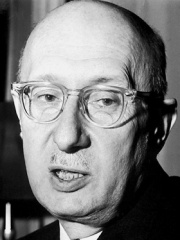
5. Georg von Békésy (1899 - 1972)
With an HPI of 72.06, Georg von Békésy is the 5th most famous Hungarian Physicist. His biography has been translated into 56 different languages.
Georg von Békésy (Hungarian: Békésy György, pronounced [ˈbeːkeːʃi ˈɟørɟ]; 3 June 1899 – 13 June 1972) was a Hungarian-American biophysicist. By using strobe photography and silver flakes as a marker, he was able to observe that the basilar membrane moves like a surface wave when stimulated by sound. Because of the structure of the cochlea and the basilar membrane, different frequencies of sound cause the maximum amplitudes of the waves to occur at different places on the basilar membrane along the coil of the cochlea. High frequencies cause more vibration at the base of the cochlea while low frequencies create more vibration at the apex. He concluded that his observations showed how different sound wave frequencies are locally dispersed before exciting different nerve fibers that lead from the cochlea to the brain. In 1961, he was awarded the Nobel Prize in Physiology or Medicine for his research on the function of the cochlea in the mammalian hearing organ.

6. Arpad Elo (1903 - 1992)
With an HPI of 63.56, Arpad Elo is the 6th most famous Hungarian Physicist. His biography has been translated into 38 different languages.
Arpad Emmerich Elo (né Élő Árpád Imre August 25, 1903 – November 5, 1992) was a Hungarian-American physics professor who created the Elo rating system for two-player games such as chess. Born in Egyházaskesző, Kingdom of Hungary, he moved to the United States with his parents in 1913. He obtained his BSc and MSc degrees in 1925 and 1928 from the University of Chicago, where he also played chess in the Chicago Chess League. From 1926 until his retirement in 1969, Elo was a physics instructor at Marquette University in Milwaukee. By the 1930s, he was the strongest chess player in Milwaukee, at the time one of the nation's leading chess cities. He won the Wisconsin State Championship eight times, and was the 11th person inducted into the World Chess Hall of Fame. He also served as the president of American Chess Federation (predecessor of United States Chess Federation) for terms 1935 and 1936. Elo died of a heart attack at his home in Brookfield, Wisconsin, on November 5, 1992.

7. Ferenc Krausz (b. 1962)
With an HPI of 61.82, Ferenc Krausz is the 7th most famous Hungarian Physicist. His biography has been translated into 45 different languages.
Ferenc Krausz (born 17 May 1962) is a Hungarian-Austrian physicist working in attosecond science. He was a director at the Max Planck Institute of Quantum Optics and a professor of experimental physics at the Ludwig Maximilian University of Munich in Germany. His research team generated and measured the first attosecond light pulse and used it for capturing electrons' motion inside atoms, marking the birth of attophysics. In 2023, jointly with Pierre Agostini and Anne L'Huillier, he was awarded the Nobel Prize in Physics. Since November 2025, he has been Chair Professor at Department of Physics in The University of Hong Kong, Pokfulam, Hong Kong.

8. Nicholas Kurti (1908 - 1998)
With an HPI of 55.26, Nicholas Kurti is the 8th most famous Hungarian Physicist. His biography has been translated into 15 different languages.
Nicholas Kurti, (Hungarian: Kürti Miklós) (14 May 1908 – 24 November 1998) was a Hungarian-born British physicist who lived in Oxford, UK, for most of his life.

9. Zoltán Lajos Bay (1900 - 1992)
With an HPI of 54.94, Zoltán Lajos Bay is the 9th most famous Hungarian Physicist. His biography has been translated into 20 different languages.
Zoltán Lajos Bay (July 24, 1900 – October 4, 1992) was a Hungarian physicist, professor, and engineer who developed technologies, including tungsten lamps and microwave devices. He was the leader of the second group to observe radar echoes from the Moon (Moonbounce). From 1930, he worked at the University of Szeged as a professor of theoretical physics. In 1923 at Tungsram Ltd., a research laboratory was established for improving light sources, mainly electric bulbs. The head of that laboratory was Ignác Pfeifer, whose research staff included Bay, along with Tivadar Millner, Imre Bródy, György Szigeti, Ernő Winter, and many others. György Szigeti worked together with Bay on metal-vapor lamps and fluorescent light sources. They received a U.S. patent on "Electroluminescent light sources" which were made of silicon carbide; these light sources were the ancestors of light-emitting diodes (LEDs). In 1955, Bay became head of the Department of Nuclear Physics in the National Bureau of Standards (NBS, called today NIST), where he measured the velocity and frequency of light by a previously unknown measurement method. As a result of Bay's research, the 1983 conference of the International Weights and Measures Bureau accepted, as a standard, the definition of a meter (metre) as recommended by Bay. In 1998, the State of Israel recognized him as among the Righteous Among the Nations and listed his name at Yad Vashem as rescuer number 6497. A relative with the same name invented Bay radial speaker:BayZ
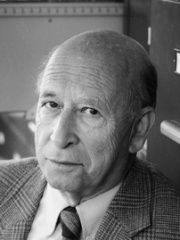
10. Valentine Telegdi (1922 - 2006)
With an HPI of 53.87, Valentine Telegdi is the 10th most famous Hungarian Physicist. His biography has been translated into 19 different languages.
Valentine Louis "Val" Telegdi (Hungarian: Telegdi Bálint; 11 January 1922 – April 8, 2006) was a Hungarian-American physicist. He was the Enrico Fermi Distinguished Service Professor of Physics at the University of Chicago before he moved to ETH Zürich. After retiring from ETH he divided his time between CERN and the California Institute of Technology. Telegdi chaired CERN's scientific policy committee from 1981 to 1983. He was chair of the International Committee for Future Accelerators, a working group of the International Union of Pure and Applied Physics, from 1983 to 1986. According to György Marx he was one of The Martians.
People
Pantheon has 11 people classified as Hungarian physicists born between 1898 and 1962. Of these 11, 1 (9.09%) of them are still alive today. The most famous living Hungarian physicists include Ferenc Krausz. The most famous deceased Hungarian physicists include Leo Szilard, Edward Teller, and Eugene Wigner.
Living Hungarian Physicists
Go to all RankingsDeceased Hungarian Physicists
Go to all RankingsLeo Szilard
1898 - 1964
HPI: 78.22
Edward Teller
1908 - 2003
HPI: 77.35
Eugene Wigner
1902 - 1995
HPI: 75.92
Dennis Gabor
1900 - 1979
HPI: 75.48
Georg von Békésy
1899 - 1972
HPI: 72.06
Arpad Elo
1903 - 1992
HPI: 63.56
Nicholas Kurti
1908 - 1998
HPI: 55.26
Zoltán Lajos Bay
1900 - 1992
HPI: 54.94
Valentine Telegdi
1922 - 2006
HPI: 53.87
Egon Orowan
1902 - 1989
HPI: 52.31
Overlapping Lives
Which Physicists were alive at the same time? This visualization shows the lifespans of the 10 most globally memorable Physicists since 1700.

